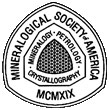 | The Mineral Identification Key |  |
 | The Mineral Identification Key |  |
Mineral Properties
In order to use this Key and the test kit described above, you need to understand some basic properties of minerals. The most important are: luster, streak, hardness, and cleavage. It is also good to know a bit about such things as specific gravity, fusibility, mineral "habits", and the types of mineral "environments" different minerals are likely to be found in – what types of rock, under what physical conditions. Brief discussions of the most important properties follow below. Any good mineral book should have more detailed sections discussing them, and the user of this Key is advised to get one and read it before working with this Key and the kit.
Luster: A mineral’s luster is the overall sheen of its surface – it may have the sheen of polished metal, or that of an unpolished metal that is pitted by weathering – or it may have the sheen of glass, or look dull or earthy, etc. Luster should not be confused with color: A brass-yellow pyrite crystal has a metallic luster, but so does a shiny grey galena crystal . Quartz is said to have a glassy (or vitreous) luster, but its color may be purple, rose, yellow, or any of a wide range of hues. The different types of luster referred to are:

Metallic, having the look of a polished metal;
Gold, 3cm tall, California

Submetallic, having the look of a metal that is dulled by weathering or corrosion; and
Euxenite, Wyoming, 2cm across
- Non-metallic, not looking like a metal at all. Nonmetallic luster is divided into several sub-types:

Adamantine, having the hard, sparkly look of a diamond;
Diamond, Zaire 1 cm.

Resinous, having the look of amber – not quite glassy;
Sphalerite, 4 cm across, Spain

Glassy/Vitreous, having the look of glass;
Pollucite 3cm. across

Pearly, having the iridescent look of mother-of-pearl (though usually just barely); often found on the cleavage face of a mineral having perfect cleavage
Stellerite, Pakistan, 2 cm across

Greasy/Oily, having the look of an oil-coated substance;
Nepheline and cancrinite (yellow) 2cm across, Maine

Silky, having the look of silk, fine parallel fibers of mineral – such as chrysotile "asbestos";
Gypsum, variety satin spar, 10cm across

Dull, having a plain looking surface that is not submetallic;
Anglesite, 2 cm across, Wisconsin

Earthy, having the look of soil or clay.
Kaolinite after orthoclase,
England, 2cm acrossCertain minerals with a resinous or adamantine luster – such as sphalerite and cinnabar respectively – can appear submetallic. Care needs to be taken in deciding which of these lusters a particular mineral has. Since getting the luster right is the first critical step in keying out a mineral, always do your best to determine what the luster of a "mystery mineral" is before going on to the next step. Return to Key: Step 1
[ Table of Contents ] [ Introduction ] [ Identification Kit ] [ Mineral Properties ] [ Environments & Associations ] [ In Conclusion ] [ The Mineral ID Key ]